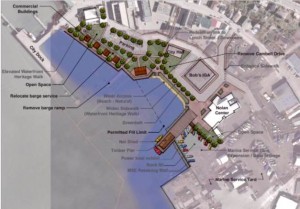
The Wrangell Borough Assembly approved the Preferred Wrangell Waterfront Master Plan on Tuesday, May 26, 2015.
The Wrangell Borough Assembly last week approved a plan for developing Wrangell’s downtown waterfront.
The Wrangell Waterfront Master Plan would put $14.7 million into improving the waterfront between City Dock and the Marine Service Center.
Wrangell Economic Development Director Carol Rushmore said the project started with a state grant for planning the future development of the downtown waterfront.
“There are a lot of competing uses for that, but there’s a lot of interest in what to do with it,” Rushmore said. “Do we expand the Marine Service Center out there? Do we want it for the public? Do we want it for tourism?”
The waterfront planning team, led by Chris Mertl of Corvus Design, held a series of public meetings in Wrangell over the last few months. The plan is based on the priorities and input of community members, and it is broken down into four phases to make the cost more manageable.
Mertl presented the final plan to the borough assembly.
“One thing that’s real important is this isn’t just a master plan,” Mertl said. “One of its goals is to provide economic opportunities to the community.”
The first phase of the plan aims to do that by expanding the Marine Service Center. Extending the fill in front of the Nolan Center would make space for 25 boats to be stored, thereby freeing up about 10 work spaces in the existing boat yard. That part of the project would cost nearly $5 million.
The second phase adds an elevated boardwalk, or Heritage Walk. It starts at City Dock, wraps around the outside of the barge area, and joins with the sidewalk along the waterfront near City Hall. This phase would include stairs going down to a natural beach area in front of town.
The focus of the third phase is adding a pier in front of the Nolan Center. The pier would include a “net shed” to be use for community events, weddings and mending nets. The pier itself could be used for fishing and short-term vessel moorage.
The fourth phase depends on the barge companies eventually moving out of the downtown waterfront. The barge area would be replaced with green space, a parking lot and small buildings for the visitor industry.
Mertl estimated that if the plan is completed, the improvements could provide up to an additional $2 million of economic opportunities each year.
But the design is a long-term vision for the community, and so far there are no immediate plans for construction.












